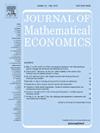Group dominant networks and convexity
IF 0.7
4区 经济学
Q3 ECONOMICS
引用次数: 0
Abstract
We study group dominant networks under convexity alone and in combination with either strategic complementarity or substitutability. Group dominant networks consists of one group of completely connected agents and a set of isolated agents. They arise frequently in the networks’ literature, most commonly in collaborative situations. We first provide two conditions that help us select from different equilibrium group dominant networks. They allow us to provide a characterization of equilibrium networks for both strategic complementarity and substitutability cases including identifying conditions for uniqueness. Next we observe that under strategic substitutability the equilibrium set may not be a convex interval, allowing for the possibility of ‘holes’ in it. We provide conditions to eliminate these holes and show that this approach can also help to simplify the process of identifying group dominant equilibria.
群优势网络与凸性
我们研究了群体优势网络在单独的凸性和策略互补性或可替代性下的组合。群体优势网络由一组完全连接的智能体和一组孤立的智能体组成。它们经常出现在网络文献中,最常见的是在协作情况下。我们首先提供了两个条件来帮助我们从不同的均衡群优势网络中进行选择。它们使我们能够为战略互补性和可替代性情况提供均衡网络的特征,包括确定唯一性的条件。接下来,我们观察到,在策略可替代性下,均衡集可能不是凸区间,允许其中存在“洞”的可能性。我们提供了消除这些漏洞的条件,并表明这种方法也有助于简化识别群体优势平衡的过程。
本文章由计算机程序翻译,如有差异,请以英文原文为准。
求助全文
约1分钟内获得全文
求助全文
来源期刊

Journal of Mathematical Economics
管理科学-数学跨学科应用
CiteScore
1.70
自引率
7.70%
发文量
73
审稿时长
12.5 weeks
期刊介绍:
The primary objective of the Journal is to provide a forum for work in economic theory which expresses economic ideas using formal mathematical reasoning. For work to add to this primary objective, it is not sufficient that the mathematical reasoning be new and correct. The work must have real economic content. The economic ideas must be interesting and important. These ideas may pertain to any field of economics or any school of economic thought.
 求助内容:
求助内容: 应助结果提醒方式:
应助结果提醒方式:


